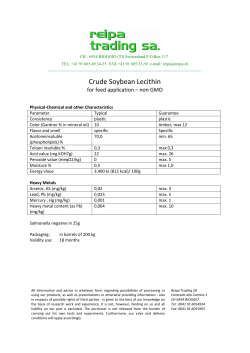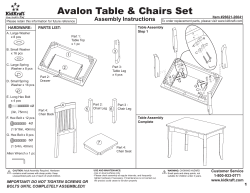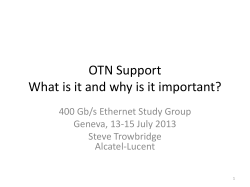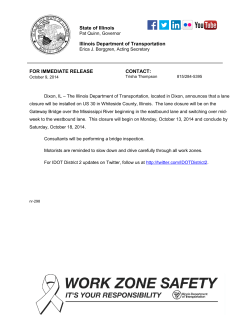
PCS and FEC baseline proposal
25G ETHERNET TASK FORCE-‐ RS/PCS/FEC IEEE 802.3by 25G Ethernet TF A BASELINE PROPOSAL FOR RS, PCS, AND FEC Eric Baden (ericb at broadcom com), presenMng Ankit Bansal (ankitb at broadcom com), Cedric Begin (cbegin at cisco com), Gary Nicholl (gnicholl at cisco com) IEEE 802.3by January 2015 Interim -‐ 25G TF
1 25G ETHERNET TASK FORCE-‐ RS/PCS/FEC Supporters Rob Stone, Broadcom Howard Frazier, Broadcom Yong Kim, Broadcom Don Cober, CoMira SoluMons Ron Muir, JAE IEEE 802.3by January 2015 Interim -‐ 25G TF
2 25G ETHERNET TASK FORCE-‐ RS/PCS/FEC MOTIVATION & GOALS • Goal is to develop a simple & efficient PCS architecture with maximal re-‐use of current 802.3 specificaMons • Two approaches available: scale up from 10G or scale down from 40G/100G • Interest in supporMng 3 FEC modes which cross the two available approaches • ImplementaMon complexity examined and reviewed – leads to conclusion that it is simplest to leverage the exisMng single-‐
lane PCS architecture to develop this next-‐gen single-‐lane PCS architecture IEEE 802.3by January 2015 Interim -‐ 25G TF
3 25G ETHERNET TASK FORCE-‐ RS/PCS/FEC HISTORY This baseline proposal is the culminaMon of many joint presentaMons that have been presented and reviewed by the study group at regular and ad-‐hoc meeMngs • "25GbE PCS Technical Feasibility" -‐ gustlin_081214_25GE_adhoc.pdf (iniMal overview of opMons) • "PCS Thoughts and ConsideraMons" -‐ kim_100114_25GE_adhoc.pdf • "25G RS/PCS ConsideraMons – A follow up" -‐ kim_100814_25GE_adhoc.pdf • "Layering and Gaps" -‐ baden_102214_25GE_adhoc.pdf • "Architectural Thoughts – 25G Interconnect" -‐ booth_102914_25GE_adhoc.pdf • "25G Ethernet Layering and Gaps" -‐ baden_25GE_01a_1114.pdf • “Architectural Thoughts – 25G Interconnect”-‐ booth_25GE_01a_1114.pdf • This baseline proposal to follow is consistent with the work built up during these contribuMons • • Source: • Plenary presentaMons: hgp://www.ieee802.org/3/25GSG/public/Nov14/index.html • Ad hoc presentaMons: hgp://www.ieee802.org/3/25GSG/public/adhoc/architecture/index.html IEEE 802.3by January 2015 Interim -‐ 25G TF
4 25G ETHERNET TASK FORCE-‐ RS/PCS/FEC OVERVIEW • 25G IS SINGLE LANE PCS • LEVERAGE EXISTING SINGLE LANE PCS (CL49) • START WITH 10G KR AND SPEED UP 25G LLC or MAC Client Datalink Layer MAC Control – USE CL46 RS LAYER (XGMII) – USE CL49 PCS MAC RS – CL46 XGMII • FEC OPTIONS: – NO FEC – USE CL74 FEC (speed up) – USE CL91 (equivalent) FEC Physical Layer PHY PCS – CL49 FEC – CL74 opMonal FEC – CL91 opMonal PMA AN – CL 73 MDI Medium IEEE 802.3by January 2015 Interim -‐ 25G TF
5 25G ETHERNET TASK FORCE-‐ RS/PCS/FEC OVERVIEW with opJonal FEC(s) PCS/FEC 25G without any FEC Block Coding Lanes 25G with CL74 FEC 25G with CL91 RS FEC 64/66B 1 1 1 RS CL46 (4B) CL46 (4B) CL46 (4B) PCS CL49 CL49 CL49 Codeword
Markers N N Y Transcode N/A N/A 256/257B Reach TBD 3+ m 5+ m Latency Low Medium High IEEE 802.3by January 2015 Interim -‐ 25G TF
6 25G ETHERNET TASK FORCE-‐ RS/PCS/FEC SOME POINTS ABOUT RS FEC • THE RS FEC REQUIRES CODEWORD (CW) BOUNDARY IDENTIFICATION: • UPDATE CL49 TO USE CW MARKERS (CWMs): – CL49 MODIFICATIONs • PERIODICALLY INSERT CWMs INTO PCS STREAM AT A CODEWORD BOUNDARY • DELETE EQUIVALENT IDLES • CWMs ONLY USED WHEN RS FEC IS ENABLED IEEE 802.3by January 2015 Interim -‐ 25G TF
7 25G ETHERNET TASK FORCE-‐ RS/PCS/FEC •
RS FEC Codeword Markers Codeword Markers (CWM): – Constructed from the concatenaMon of CL82 MLD 4 Alignment Markers 0 thru 3 IEEE 802.3by January 2015 Interim -‐ 25G TF
8 25G ETHERNET TASK FORCE-‐ RS/PCS/FEC RS FEC CWM (cont.) • CW MARKERS (CWM): – FORMAT • Almost idenMcal to CL82 40G MLD4 AMs • BIP is not used and forced to fixed (tbd) values. – INSERTION RATE • Every 16384*5*66 = 1024 Code Words. – DELETE EQUIVALENT IDLES • Re-‐use CL49 Clock CompensaMon Mechanism (SecMon 49.2.4.7 Idle (/I/) ) – ONLY INSERTED WHEN RS FEC IS ENABLED – MAINTAINs BASICS of: • CL91 FEC SYNCHRONIZATION STATE FSM (Figure 91-‐8) • CL91 FEC ALIGNMENT STATE FSM (Figure 91-‐9) IEEE 802.3by January 2015 Interim -‐ 25G TF
9 25G ETHERNET TASK FORCE-‐ RS/PCS/FEC RELATED CLAUSES • MULTIPLE CHANGES REQUIRED: – CL45 – MDIO (addressable register set) – CL49 – Single Lane 64b/66b PCS – CL91 – RS FEC for 100G • MINIMAL CHANGES REQUIRED: – CL46 – XGMII ReconciliaMon Layer – Speed up only – CL74 – KR FEC – Speed up only IEEE 802.3by January 2015 Interim -‐ 25G TF
10 25G ETHERNET TASK FORCE-‐ RS/PCS/FEC •
CL45 (MDIO) CHANGES CL49 Related Register Changes: – Add CL49 10GBASE-‐R PCS control for CWM inserMon and IDLE deleMon •
Use PCS Control 2 Reg? • CL91 Related Register Changes: – Maintain 100GBASE-‐R FEC Control/Status bits •
•
•
•
•
•
•
SMll per ‘PHY’ PCSLane alignment status register applicable, but for one lane only. FECLane alignment register applicable, but for one lane only. RS FEC lane mapping register is not applicable. Maintain RS FEC symbol errors counter for lane 0 only. RS FEC BIP Error Counters are not applicable. RS FEC PCS Alignment status register is not applicable. • GENERAL Changes: – Add 25G CR4/KR4 to NegoMated Port Type – Add 25G CR4/KR4 to Backplane Ethernet, BARE-‐R copper status register – OTHER? IEEE 802.3by January 2015 Interim -‐ 25G TF
11 25G ETHERNET TASK FORCE-‐ RS/PCS/FEC CL49 (PCS) CHANGES • Add/update secJons for the inserJon of CWMs and deleJon of equivalent IDLEs or ordered sets. – Update Figure 49-‐4 (FuncMonal Block Diagram) to include IDLE DeleMon and CWM InserMon funcMons – Add paragraph in SecMon 49.2.2 (FuncMons within the PCS) to include IDLE deleMon funcMon and CWM InserMon funcMons. – Update Figure 49-‐5 (PCS Transmit bit ordering) to include IDLE DeleMon and CWM InserMon funcMons. – Update paragraph 49.2.4.7 (IDLE /I/) to indicate IDLEs may be deleted to offset CWM inserMon. – Update paragraph 49.2.4.10 (ordered_set /O/) to indicate ordered sets may be deleted to offset CWM inserMon. – Update paragraph 49.2.5 (Transmit Process) to include IDLE DeleMon and CWM InserMon funcMons – Add secMon 49.2.65 (Alignment Marker (CWM) InserMon) to describe details of AM inserMon funcMon. IEEE 802.3by January 2015 Interim -‐ 25G TF
12 25G ETHERNET TASK FORCE-‐ RS/PCS/FEC CL91 CHANGES -‐ OVERVIEW • Maintain the same register set as the 100G RS-‐FEC • Add/Update secMons to show the following: – Remove MLD funcMons: • TX: –
–
–
–
–
Block Lock AM lock except for one FEC lane Deskew Re-‐order Symbol distribuMon • RX: –
–
–
Alignment lock except for one FEC lane Deskew Block DistribuMon – Change AM removal, mapping, and inserMon for both RX and TX • Different number of AMs (CWM) inserted and deleted. • Single FEC lane (0) and new AM to FEC lane mapping. –
For TX and for RX (removal) – Transcoding changes • Extending the control blocks to support CL49 as well as CL82 types IEEE 802.3by January 2015 Interim -‐ 25G TF
13 25G ETHERNET TASK FORCE-‐ RS/PCS/FEC CL91 CHANGES -‐ DETAILS • Lane block synchronizaJon (91.5.2.1) – Change to Block SynchronizaMon – Change text to indicate a single lane (FEC:IS_UNITDATA_i.request) provides a stream of data to this funcMon. It obtains lock to the 66-‐bit blocks in the bit stream using the sync headers, and outputs 66-‐bit blocks. Block lock is obtained as specified in the block lock state diagram in Figure 82-‐10. • Alignment lock and deskew (91.5.2.2) – Change to Codeword Marker Lock – Change text to indicate Codework Marker lock is obtained by using the alignment marker lock state diagram in Figure 82-‐11, with the following changes:
•
•
X has a value of 0 only, represenMng the 40G MLD AM0 encoding (only lane 0 is considered) Change am_counter variable in 82.2.18.2.4 Counters to indicate the AMs are separated by 16383*5 66 bit blocks • Lane Reorder (91.5.2.3) – Remove this secMon. IEEE 802.3by January 2015 Interim -‐ 25G TF
14 25G ETHERNET TASK FORCE-‐ RS/PCS/FEC CL91 CHANGES – MORE DETAILS • Alignment marker removal (91.5.2.4) – Change to Codeword Marker removal – Change text to indicate that once Codeword Marker lock is obtained (as indicated by am_lock), the Codework Marker is removed from the data stream. • Figure 91-‐2 (FuncMonal block diagram): –
–
–
–
–
–
–
–
Change TX interface to include FEC:IS_UNIDATA_0.request only Change “Lane block synchronizaMon” to “Block SynchronizaMon” Change TX direcMon “Alignment lock and deskew” to “CWM lock” Remove TX direcMon “Lane reorder” Remove “Symbol distribuMon” Change RX direcMon “Alignment lock and deskew” to “CWM lock” Remove RX direcMon “Lane reorder” Remove “Block distribuMon” IEEE 802.3by January 2015 Interim -‐ 25G TF
15 25G ETHERNET TASK FORCE-‐ RS/PCS/FEC CL91 CHANGES -‐ MORE DETAILS •
Alignment marker mapping and inserJon (91.5.2.4) – Change to CWM mapping and inserMon – Change text to the following: The codeword markers that were removed per 91.5.2.4 are re-‐inserted axer being processed by the codeword marker mapping funcMon. The RS-‐FEC receive funcMon uses knowledge of this mapping to idenMfy RS-‐FEC codeword boundaries. The codeword marker mapping funcMon operates on a group of four codeword markers. Let am_tx_x<65:0> be the codeword marker “x”, x=0 to 3, where bit 0 is the first bit transmiged. The codeword markers shall be mapped to am_txmapped<256:0> in a manner that yields the same result as the process defined below. a) am_txmapped<64x+63:64x> = am_tx_x<65:2> for x = 0 to 3 b) amp_txmapped<256> = 1 One group of codeword markers are mapped every 5 x 16384 66-‐bit blocks. This corresponds to 1024 Reed-‐
Solomon codewords. The mapped codeword markers, am_txmapped<256:0> shall be inserted as the first 257 message bits to be transmiged from every 1024th codeword. IEEE 802.3by January 2015 Interim -‐ 25G TF
16 25G ETHERNET TASK FORCE-‐ RS/PCS/FEC CL91 CHANGES -‐ MORE DETAILS •
Reed Solomon Encoder (91.5.2.7) –
–
•
Alignment lock and deskew (91.5.3.1) –
–
•
Add a paragraph at the end: The output of the encoder is connected to the PMA:_IS_UNITDATA_0.request input one 10-‐bit symbol at a Mme, in a concatenated order. Change to Codeword Marker lock Change text to indicate the RS-‐FEC receive funcMon forms a bit stream from the PMA:IS_UNITDATA_0.indicaMon primiMve. It obtains codeword marker logic and performs codeword validity checks as indicated by the FEC synchronizaMon state diagram shown in Figure 91-‐8 and the FEC alignment state diagram show in Figure 91-‐9 FEC synchronizaJon state diagram (Figure 91-‐8) –
–
–
–
Remove FEC_lane_mapping and fec_lane variables. Redefine amp_valid: Boolean variable that is set to true if the received 64-‐bit block is a valid alignment marker payload. The alignment marker payload consists of 48 known bits and 16 variable bits (the BIP3 and CD3 field and it’s compliment BIP7 and CD7, see 82.2.7). The bits of the candidate block that are in the posiMons of the known bits in the alignment marker payload are compared on a nibble-‐wise basis (12 comparisons). If no more than 3 nibbles in the candidate block fail to match the corresponding known nibbles in the alignment marker payload, the candidate block is considered a valid alignment marker payload. For the normal mode of operaMon, the lane compares the candidate block to the alignment marker payload for PCS lane 0, from the 40G MLD 4 specificaMon. Change all_locked to indicate x=0 only. Change amp_counter to count 1024 FEC codewords that separate the ends of two consecuMve, normal codeword marker payload sequences. IEEE 802.3by January 2015 Interim -‐ 25G TF
17 25G ETHERNET TASK FORCE-‐ RS/PCS/FEC CL91 CHANGES -‐ MORE DETAILS •
FEC alignment state diagram (Figure 91-‐9) –
–
•
Lane Reorder (91.5.3.2) –
•
Change text to indicate the first 257 bits in every 1024th codeword is the vector am_rxmapped<256:0>. 256B/257B to 64B/66B transcoder (91.5.3.5) –
•
Remove symbol distribuMon Remove PMA_UNIDATA_[{1,2,3}].request interfaces Distribute all symbols in concatenated order to PMA_UNIDATA_0.request Alignment marker removal (91.5.3.4) –
•
Remove this secMon FIGURE 91-‐6 (Transmit bit ordering) –
–
–
•
Remove DESKEW, DESKEW_FAIL, and ALIGN_ACQUIRED states. Replace test_cw from ALIGN_ACQUIRED with all_locked Change secMon f2 to refer to block types using Figure 49-‐7 Block distribuJon (91.5.3.6) –
Remove this secMon IEEE 802.3by January 2015 Interim -‐ 25G TF
18 25G ETHERNET TASK FORCE-‐ RS/PCS/FEC CL91 CHANGES -‐ MORE DETAILS •
Alignment marker mapping and inserJon (91.5.3.7) –
–
•
Change to CWM mapping and inserMon Change text to the following: The codeword marker mapping funcMon derives the codeword markers, am_rx_x<65:0> for x = 0 to 3, from am_rxmapped<256:0>. The codeword markers shall be derived from am_rxmapped<256:0> in a manner that yields the same result as the following process. For x=0 to 3, am_rx_x<65:0> is constructed as follows: am_rx_x<0>=1 and am_rx_x<1>=0. am_rx_x<25:2> is set to M0, M1, M2 as shown in Figure 82-‐9 using the values in Table 82-‐3 for PCS lane number x. am_rx_x<33:26> = am_rxmapped<64x+31:64x+24> am_rx_x<57:34> is set to M4, M5, M6 as shown in Figure 82-‐9 using the values in Table 82-‐3 for PCS lane number x. am_rx_x<65:58> = am_rxmapped<64x+63:64x+56> Receive bit ordering (Figure 91-‐7) –
–
–
–
Remove PMA_UNITDATA_[{1,2,3}].indicaMon interfaces. Show that all symbols are received via the PMA_UNIDATA_0.indicate interface. Change “Alignment lock, deskew, and lane reorder” to “CWM lock” Change arrow at top from “To Block distribuMon” to “To Alignment InersMon” IEEE 802.3by January 2015 Interim -‐ 25G TF
19 25G ETHERNET TASK FORCE-‐ RS/PCS/FEC THANK YOU! IEEE 802.3by January 2015 Interim -‐ 25G TF
20
© Copyright 2025









